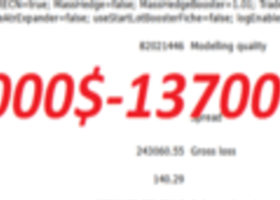
Pound’s Rally Against New Zealand Dollar to be Tested by Formidable Resistance
The British pound has corrected higher against the New Zealand dollar following the Reserve bank of New Zealand’s decisionto cut interest rates at its March rate meeting.
This is the pound’s chance to build a base and move higher but given stubborn EU referendum headwinds and recent weak data, this may be a struggle.
The pound has strengthened more versus the kiwi than most currencies having already formed a three-wave a-b-c corrective pattern higher:
Everything is pointing to the possibility of a broader move higher too, with MACD sharply converging with price and confirmation from On Balance Volume (OBV) which is also converging with price.
When indicators converge with price it is a bullish signal as new lows in price fail to create new lows in momentum or volume, signalling a loss of strength in the down-trend.
In this case the lack of momentum and volume as measured by MACD and OBV gave early warnings of the possibility of a correction higher, which may be the start of a broader up-move, however, for more confirmation we would ideally wish to see a break of the 2.1502 highs, as well as a break out of the descending channel and above the 50-day moving average at 2.1671.
A clear move above these formidable resistance levels would help signal a more convincing rally higher, with a break above 2.1800 providing compelling confirmation of an extension up to a target at 2.2047 at the R1 monthly pivot.
Given the correction so far has still only formed a three-wave a-b-c correction higher, this could just be a correction within the dominant down-trend, and as such there remains the possibility the pair could capitulate and move lower, with a break below the 2.08412 B wave lows confirming a move down to at least re-touch the 2.06230 February 26 lows.
What Will Matter for Sterling This Week
On paper the following week looks laden with potentially market-moving event risk, given the Budget, the Bank of England (BoE) rate decision and the release of both unemployment and wage data.
In reality, however, it’s unlikely the BoE will say or do anything different in relation to policy until the referendum has passed, the Budget doesn’t normally affect exchange rates particularly from past experience and wage data is unlikely to rise spectacularly – however, ultimately the case can be made for more volatile outcomes as well.
For example, the BoE governing council could show further EU sympathies in a similar or stronger vein to those expressed by Carney and Cunliffe at the recent Parliamentary Committee testimony on the BOE’s stance on Brexit, and this endorsement might shift sentiment in favour of the pound since the BOE’s platinum endorsement is a strong ally lending the ‘stay’ campaign credibility in the eyes of a large portion of ‘undecideds’.
According to a paper edited by Vicky Redwood, chief economist at Capital Economics, the week is likely to be rather uneventful:
“The MPC minutes released on Thursday, alongside the rate decision, should show that heightened uncertainty about the economic outlook makes the decision to leave rates on hold unanimous.”
As for the Budget, according to Capital Economics’ Scott Bowman it unlikely to support growth since the chancellor is certain of continuing with austerity, a policy which does not mix well with loose monetary policy:
“With the Chancellor constrained by his fiscal mandate, the Government is unlikely to provide any support for the recovery or take advantage of low gilt yields to increase investment.”
“Remember, the Government’s fiscal mandate calls for a surplus on public sector net borrowing (PSNB) by 2019/20. The Chancellor may even increase austerity further if the OBR presents him with detrimental forecasts.
“This contrasts with the extremely loose stance on monetary policy. Indeed, with the MPC certain to keep interest rates on hold on Thursday, Bank Rate is set to have been at a record low of 0.5% for seven whole years. This doesn’t necessarily make for the ideal policy mix.
“Indeed, if Mr Osborne does announce more austerity, there will probably be renewed questions about the wisdom of his fiscal rule. The rule means there is little flexibility to respond to downturns in the economy. And with Bank Rate close to its lower bound, monetary policy is already doing a great deal to support the recovery.”
Accepting Capital Economics’ analysis, therefore, the budget is unlikely to provide support for sterling.
Kiwi Drivers to Watch
The main event for the New Zealand dollar this week, is probably the Global Dairy Auction on Tuesday.
Investors will be keen to see if the rally in global commodities has extended to dairy products which are New Zealand’s largest export.
The fall in dairy incomes as a result of a continued fall in dairy prices has been a major weight on inflation expectations, and one of the causes of the recent RBNZ rate cut.
In a note on the New Zealand Dollar, Banco Intesa San Paolo, forecast the currency to continue lower versus the Dollar:
“We confirm our expectations for a weakening of the New Zealand dollar in the near term, towards NZD/USD 0.62-0.60 on a 1m-3m horizon. This is the time horizon on which the RBNZ may implement another interest rate cut, in full divergence compared to the Fed, which, by contrast, should resume hiking rates between 2Q and 3Q.”
They are likewise bearish in their analysis of the EUR/NZD pair and although there is no analysis of Sterling one can assume that weakness or perhaps at the most a sideways forecast must be extrapolated.
PS: Copy signals, Trade and Earn on Forex4you - https://www.share4you.com/en/?affid=0fd9105


